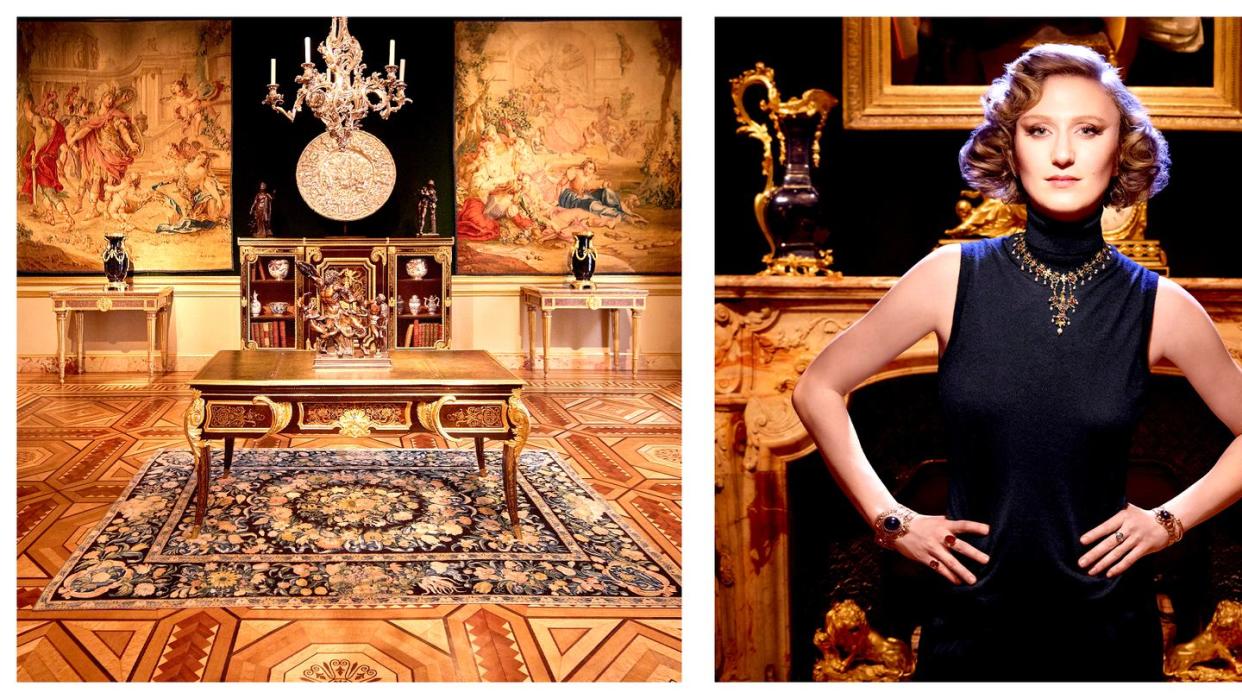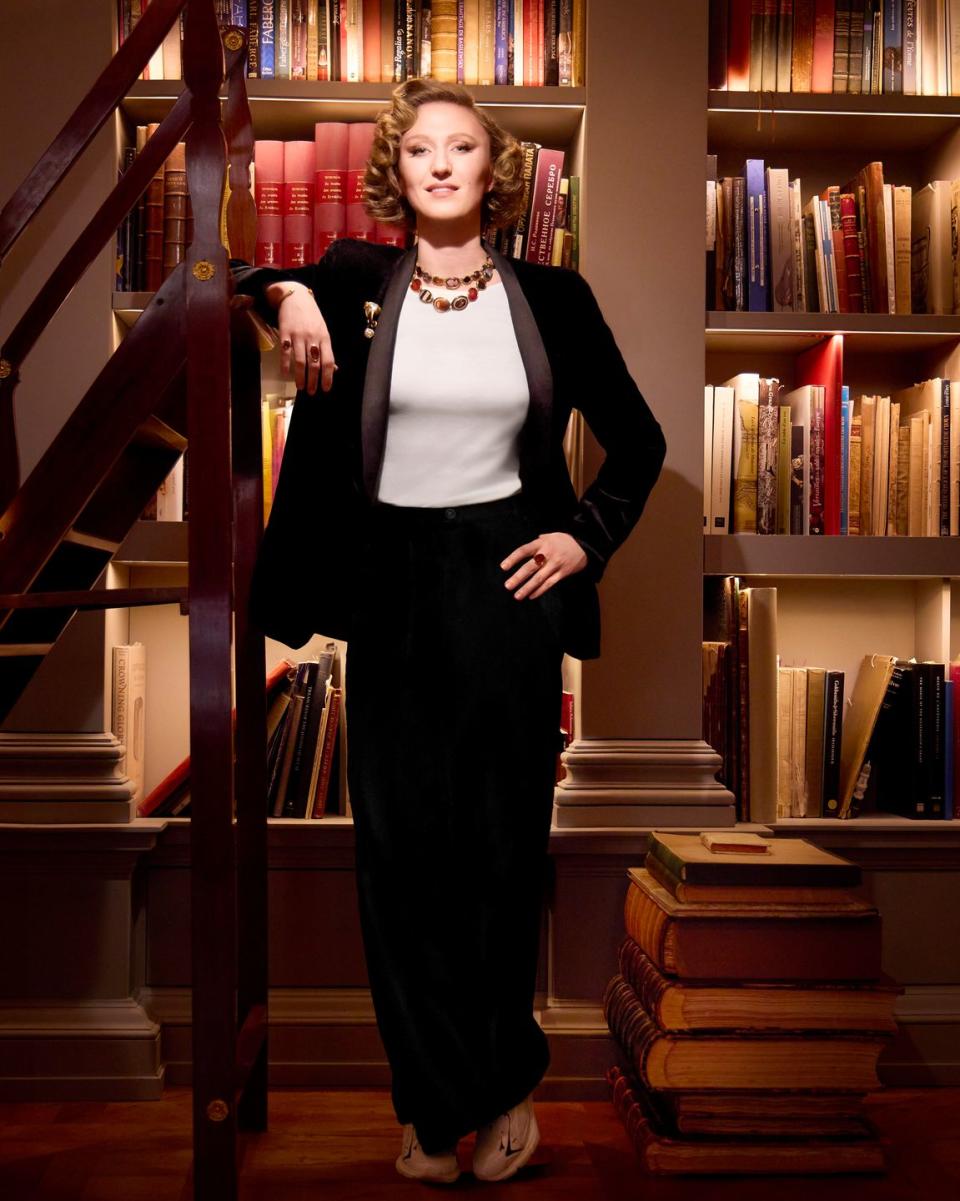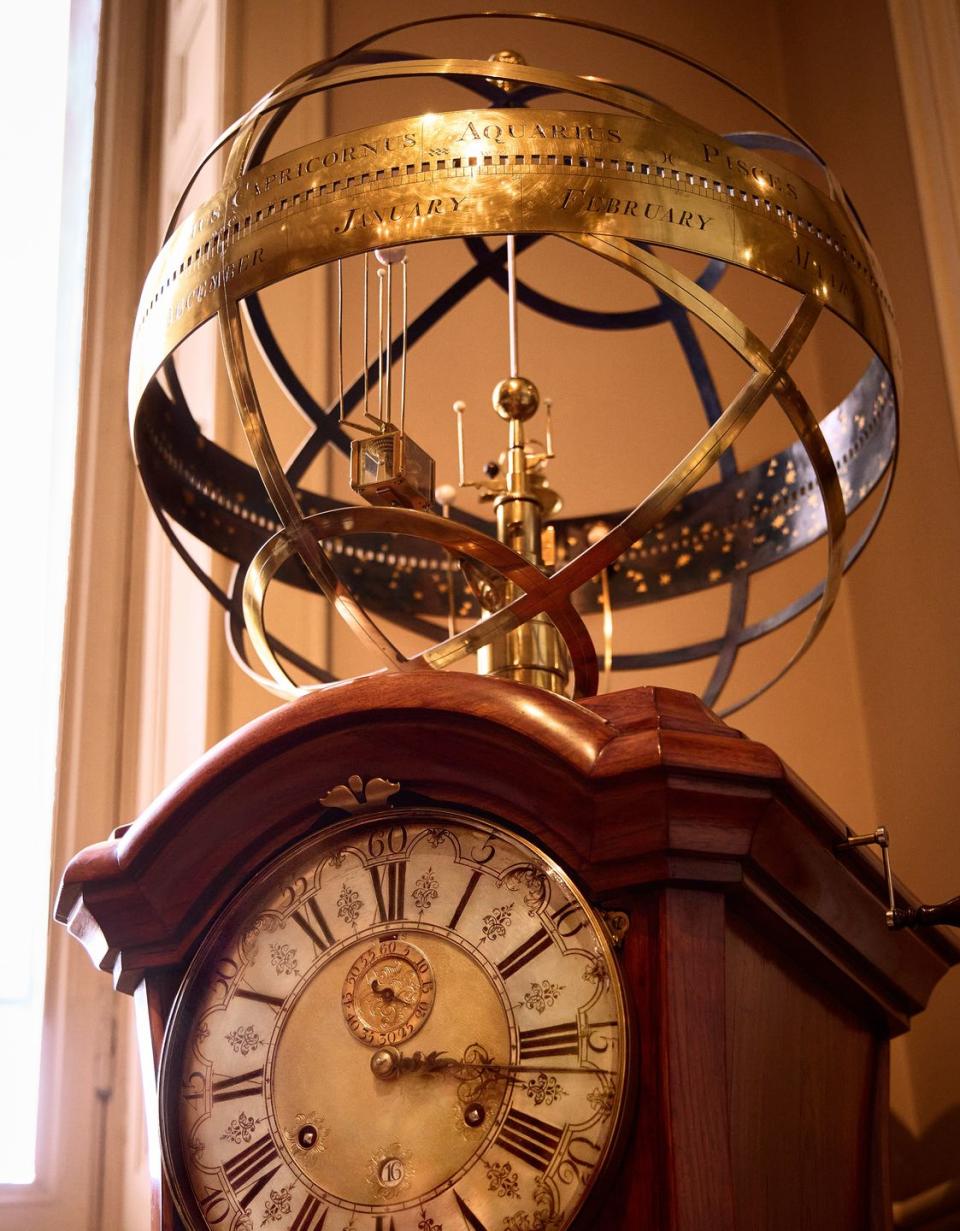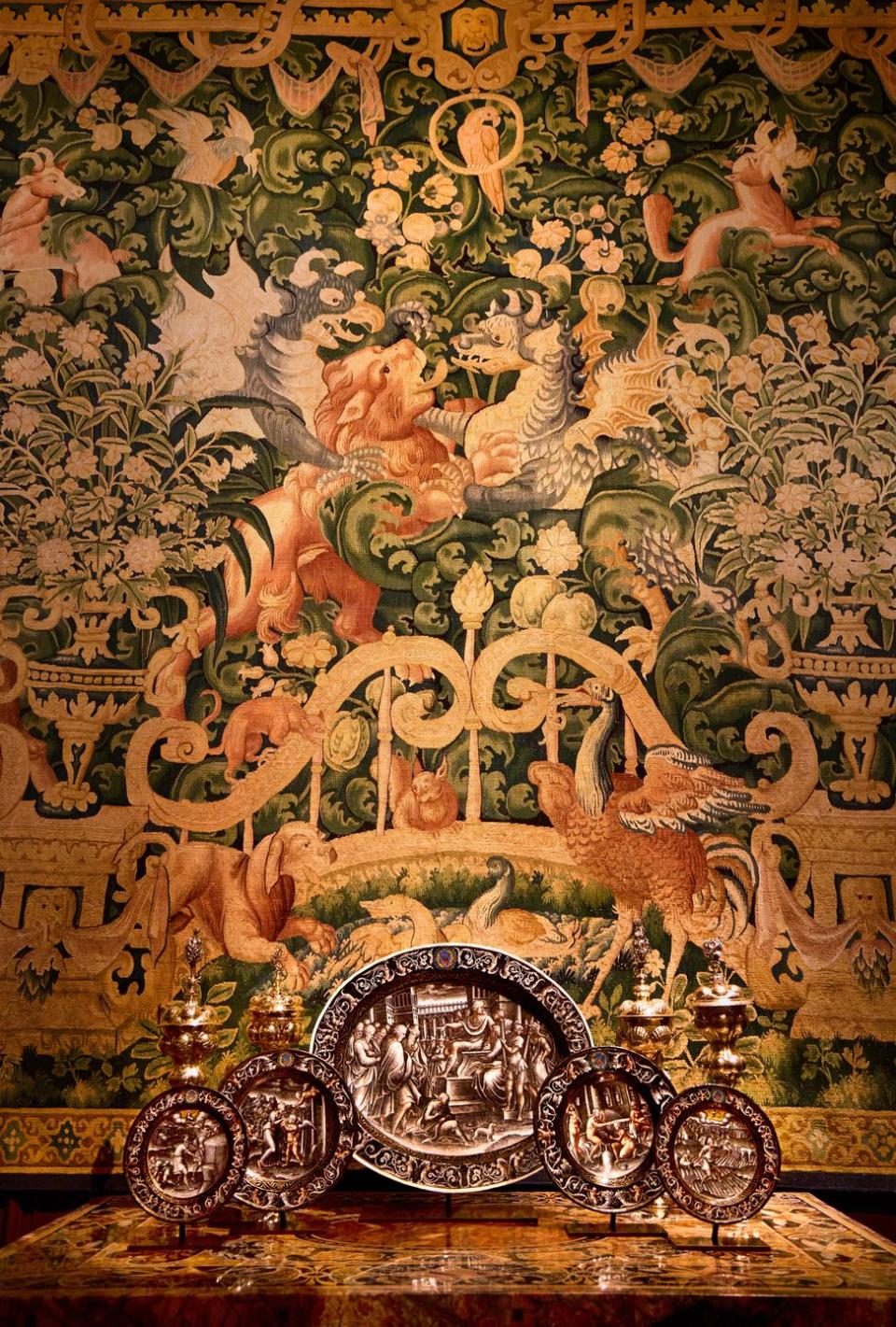How Laura Kugel Became the Go-To Antiques Dealer for the World's Most Discerning Clients

The lovely, unassuming young lady making her way down the Quai Anatole France in sneakers could be a graduate student. She wears no makeup and exudes a vibe of general intelligence, that of someone living a life of the mind. However, instead of proceeding to the Sorbonne, she turns to enter an imposing hôtel particulier with no signage. After ascending a flight of stone stairs and walking through one of the most imposing suites of rooms in Paris, she arrives at her office. This is Laura Kugel, and if we follow her inside we will find ourselves in a world of opulence, history, and wonder. We are all welcome: Galerie Kugel is open to the public by appointment, although it takes a certain amount of nerve to ring the bell.
Some background remarks about where we are and what we can expect to experience inside. All great art dealers have a certain mythology about them; they do more than transact sales. Often, through force of charisma and will, they change the culture within which they operate. Lord Joseph Duveen was said to rehearse his pitches to the inscrutable Andrew Mellon by having his valet sit on the end of the bed and say nothing in response to his employer’s enthusiasm (“You be Mellon”). It worked: We have the National Gallery today. After the dealer’s death Mellon revealed that he had enjoyed Duveen’s bumptiousness. “The pictures were beautiful,” he said, “but never so beautiful as when he was standing in front of them.”
In New York, Wildenstein & Co. had its famous private showroom upholstered entirely in crimson velvet, designed to intimidate and seduce; when you were admitted and confronted with a single painting on an easel, they wouldn’t let you out until the sale was closed.

Kugel is the last antiquarian gallery that has this sort of mystique. The first time I entered I was greeted with smiles, and I smiled back, but I was much too afraid to ask the price of anything. If Henry Clay Frick were alive, he would come shopping here.
Now that you’re past the door, there’s no choice but to bluff it out and try to have a good time. My first visit was to their former premises, on Rue Saint-Honoré, for “Sphere,” an exhibition of globes and scientific instruments, in 2002. The vaguely sweaty feeling that accompanied my early moments inside gave way to a very friendly experience. My second, arranged by the late decorator François Catroux (a major client), was to the mansion they now occupy on Quai Anatole France. Kugel has been here since 2004, in premises decorated by François-Joseph Graf, notable for its singular success in combining the treasures on offer with lessons in chic. You can learn a lot about decorating from looking at color and furniture arrangement at Kugel.
For a uniquely informed view of what sets Kugel apart, I spoke to Tobias Meyer, the former chief auctioneer and worldwide head of contemporary art at Sotheby’s. There is no figure in the art world quite like Meyer. At Sotheby’s he had to find perhaps three market-making paintings a year to sell. His success made him one of the architects of the modern art economy, as he personally arranged to bring to auction many of the works that have driven escalating prices. Meyer’s personal passion, however, is 18th-century objects and furniture. He is not much of a retail shopper in general, since he knows how to find things before they enter “the system,” but no one is more knowledgeable. With laserlike precision he explains what Kugel is doing that makes it different from anybody else. “Apart from their depth of expertise, and enormous inventory of museum-quality objects, what really sets them apart is their investment in provenance research. It enables them to trace back important works of art to 18th-century owners. They can do this by having established a database of the auction catalogs of that period in Paris, at the time the center of the art world. It is unique and a brilliant strategy of matching excellence with detailed and precise research.”
In a business known for caveat emptor, why and how has this occurred here? Laura credits her father Alexis and uncle Nicolas with one unconventional decision, made in 1998. “The first step, I believe, was when they stopped doing the Biennale in Paris,” she says. “Instead of having a booth there, we began an in-house exhibition schedule. Like the one you visited for ‘Sphere.’ ” (I don’t mention the sweating.) “Basically, they decided there was more depth to be had—and more creativity—when you’re master in your own gallery, and in control of your own time and topics. And making scholarship along with the selling, in the form of art books about each show.” For this reason Kugel has excellent relationships with museums like the Met, the Frick, and the Louvre, in proportion to their reputation for integrity.
It is fair to say the Kugel library is one of the recent miracles of art and architecture in Paris. If we’re invited into this library, we find a room that looks for all the world as if it has been here since the 16th century. But the building is from the 19th, and this room is in fact five years old. “We had a great space, and my father and uncle had always had such a thing high on their wish list. Our library was designed not by Graf but by Pier Luigi Pizzi, an opera set designer from Venice. Not just for show, this is a work tool. We have a full-time librarian and a team of trained art historians, and it’s our biggest asset in terms of research—full of rare books, auction catalogs, and things like 18th-century auction records, where we can find provenance for pieces and understand them and tell their stories properly.”

It is also a means of communicating Kugel’s commitment to knowledge. What experienced collectors know, because it is their business to know, anyone invited to the library (unlike the gallery, it is not public) can now see for themselves. This room is the engine of the edge Meyer described. Laura agrees—but points out a high-class problem. “We made it a bit too nice, actually. When you have a nice library, designed for beauty as much as capacity, you run out of space immediately.”
A baroque library worthy of a Medici scholar is very nice, but… Enter Instagram—the secret weapon, the key anyone can use to enter the kingdom of bimbo instant fame. In this case, in the hands of the younger generation, a peculiar alliance has arisen between social media and a gallery that could intimidate a Rothschild. In Laura’s hands Instagram has taken the opportunity to show that art history and collecting can be fun. Among all the major dealers, Kugel’s is the only Instagram feed with stories, animation, emojis, humor—and heart. The passion about what they stand for and have to share is evident in every post. There is no mention of money. On Instagram the gallery behaves like a museum and a teaching entity—this is, in fact, the way museums should present themselves on social media, with the kind of energy and wit it takes to win in this context. At the moment Laura and the gallery have 8,800 followers, but no one doesn’t love their style.
Instagram offers one kind of storytelling, the journeys of objects another. I ask Laura to tell me the history of a piece that has passed through Kugel’s hands more than once—a story to illustrate the gallery’s relationship with collectors and the market. She chooses a group of 16th-century enamels that traveled from one famous fashion designer’s home to another, with Kugel in between. We begin with Hubert de Givenchy, a two-story palace on the Rue de Grenelle, and an ailing dog.
“In the early 1990s Hubert de Givenchy—who was already a client of my grandfather Jacques—called Alexis and Nicolas to tell them he was thinking of selling the second floor of his famous hôtel particulier because his dog was sick and could no longer walk up the stairs. He thought of them to handle his collection of Limoges Renaissance enamels.” Now, Givenchy had collected Limoges over many years, back when they were not very much sought after by collectors. He favored “grisaille” pieces, whose beautiful near-monochrome quality gave the ensemble a striking plain aesthetic. Alexis and Nicolas bought the whole set. Then they displayed the pieces at the 1994 Paris Biennale alongside the famous Armoire au Char d’Apollon by André-Charles Boulle, the cabinet in which the collection was displayed in Givenchy’s house. “Givenchy himself designed the booth for us.”
“Part of the Givenchy collection of enamels were four plates and one large oval dish, all in grisaille [black and white painting as opposed to multicolor]. They were made by Pierre Reymond in Limoges around 1570 and bear the arms of the Chaspoux family, who originally commissioned an armorial service. Twenty pieces from this service are today identified, mostly in museums.”
Are you paying attention? We’re about to transact a major sale to another name you may find familiar. “Here is the key: The entire collection was presented as a set and immediately purchased by Pierre Bergé on opening night. Rumor of this sale spread, and suddenly many collectors started searching for similar pieces. American collectors in particular asked Alexis and Nicolas to recreate a similar collection for them. Meanwhile, Bergé and Yves Saint Laurent continued to pursue collecting Limoges. The five pieces originally commissioned by the Chaspoux were among the rarest pieces in Givenchy’s collection. But at the YSL Bergé Christie’s sale, each work was sold as an individual lot, and we bought many back—including the Chaspoux, which had now belonged successively to two of the best French collections of the 20th century.”
Now we move from fashion royalty to royal royalty. “We then sold them to a private collector who was starting to care for Limoges, but we quickly bought them back when one of our greatest clients, Sheik Hamad Al Thani, inquired about them. They were then sold and remained with him until last year, when we purchased them back once more—piece by piece—at Sotheby’s auction of the contents he had assembled for the Hôtel Lambert. So in the past 30 years, in no small part because of the exposure given to these particular examples by their owners, the market for Limoges enamels has exploded, and many collectors new to the market are searching for the best pieces, going back to how sought after they used to be at the time of J.P. Morgan, Frick, and Walters.”
Having finished her story, Laura concludes with a point about the specific role the gallery has played at each moment when a collection might instead have become a memory, beautiful things now scattered around the globe. “What this shows me is that collectors and dealers not only share their passion for art but that they are capable of creating ensembles and having them live on as sets, on to their next home. This is something auction houses cannot replicate, since their business model is to sell volume, piece by piece, sadly sometimes dismantling collections rather than preserving them.”
So where does Kugel expect to find itself in 15 years? With the lion’s share of money and attention in the art market having gone over to contemporary, will the gallery ever make any concessions to the Dark Side? And with fewer J.P. Morgans born every year, are there any plans for a Kugel Lite, pricewise?
She smiles vaguely at a question she has obviously been asked before. “That’s a conversation that has been in my mind from time to time,” Laura says. “During the pandemic hiatus, a lot of colleagues survived by selling cheaper material—going for volume and not so much the great things. We pondered that. But we have to recognize ourselves for what is our strength: We are the aspirational entity. We are here to work very hard to find the best possible pieces and inspire people through that. We are the best at doing it, and we would disappoint people if we tried to do something we could not be the best at. Modern art doesn’t need our help.”

Kugel’s business is history, and at the top of the top, business is booming. Sometimes the biggest risk is to resist caprice and double down on who you are. In a culture trending toward the lowest common denominator, one powerful figure familiar with forces in the art world (and cynical about many of them) dismisses such questions with a wave of the hand: “They will survive all.”
Eminent decorator Robert Couturier says, “It is where the rarest and most beautiful memories of the world go for sale. Where we can admire them and, if we’re lucky, propose them to our clients. I wish I could go every day.”
This story appears in the Summer 2024 issue of Town & Country. SUBSCRIBE NOW
You Might Also Like


